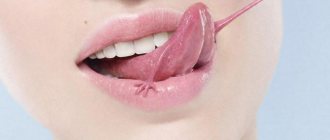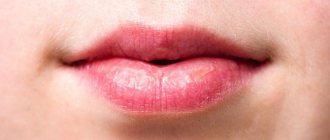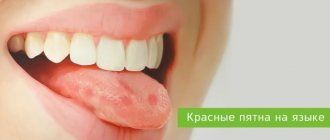At home, you can conduct a quick health diagnosis yourself. All that is necessary for this is to examine the tongue with a mirror. A change in its color and shape will tell you a lot about the functioning of internal organs. This simple method should not be neglected. With its help, you can prevent the development of dangerous pathologies in time. Some of them are indicated by a rough tongue.
Tongue is an indicator of health
It is recommended to examine the tongue in the morning, on an empty stomach. In a healthy person, its color is pale pink, and the taste buds are easily distinguishable. Normally, it has a faint whitish coating that can be easily removed with a toothbrush or a special scraper. The complete absence of such cover should be no less alarming than its excessive amount.
Any changes that occur in the oral cavity should attract a person’s attention. They may indicate the formation of pathological processes in the body. A decrease in the amount or complete cessation of saliva production leads to the development of severe dry mouth. A rough tongue will immediately signal this to a person, since due to a lack of moisture on its surface, difficulties will arise when swallowing and chewing food.
Dry tongue can occur with severe nervous excitement or stress. From a physiological point of view, this is a normal situation. As soon as the person calms down, saliva production returns to normal. If there have been no emotional upheavals, and dryness has been observed for a long time, you should look for other causes of a rough tongue. An experienced doctor will help in this situation.
The causes of dry tongue may be the following:
- dehydration and intoxication;
- heart pathologies;
- tongue burn;
- disorders of the gastrointestinal tract;
- glossitis;
- chronic tonsillitis;
- liver pathologies;
- stagnation of food;
- blood diseases;
- HIV;
- kidney problems;
- long-term use of antibiotics;
- inflammation of the salivary glands, as well as their malignant and benign tumors;
- diabetes;
- infectious lesions.
Despite the impressive list of pathologies that cause roughness and dryness of the tongue, diseases of the gastrointestinal tract, pulmonary system, and infections are most often diagnosed. Only a doctor can make a correct diagnosis after a thorough diagnosis. He will prescribe treatment that will help defeat the underlying disease. After this, the rough tongue will definitely return to normal.
Gastroesophageal reflux disease. Drug treatment
Medications are prescribed by the doctor, taking into account the individual characteristics of the course of the disease and the clinical manifestations of the examination data.
All drugs used for the treatment of gastroesophageal reflux disease (GERD) can be divided into 3 groups.
Read also: How to move a table up in Word?
- Antacids that quickly neutralize hydrochloric acid and bile, their duration of action is short, and they are used as symptomatic treatment: Gaviscon (sodium salt of alginic acid from algae), Phosphalugel containing agar-agar, Maalox, phosphalugel, Rennie, rotor, vicalin, gastal, magalfil. However, many antacids (that is, acid antagonists) have a significant drawback. By neutralizing acid, they make the reaction in the stomach alkaline. And this serves as a signal for the stomach to produce a new portion of hydrochloric acid, and therefore a new attack of heartburn. Because of the rebound effect, these medications are only suitable for use by healthy people, and not by people suffering from reflux esophagitis.
- Prokinetics that prevent backflow and improve the evacuation of food from the stomach - Motilium, Cerical, Metaclopramide, Motilak. This group can be used for course and maintenance treatment and in combination with gastric manifestations (distension and fullness of the stomach, nausea, rapid satiety, heaviness after eating). It should not be used for a long time, especially for men.
- Antisecretory drugs: histamine H2 receptor blockers (Ranitidine, Famotidine, Nizatidine) and proton pump inhibitors (PPIs) (Omeprazole, Lansoprazole, Pantoprazole, esomeprazole), which have the most pronounced antisecretory effect and are the drugs of choice for GERD.
Pathologies of the digestive tract
Reflexes that can influence the motor and secretory functions of the stomach and intestines are produced by tongue receptors. The opposite effect also occurs. That is, internal organs influence the appearance of pathological reflexes on the surface of the tongue. For example, its rough root and white coating will tell the doctor that the patient suffers from gastritis with low acidity. Pain and burning sensations in the esophagus, heartburn can complement the clinical picture.
A rough tongue covered with a gray coating may indicate the development of an intestinal ulcer. An additional factor indicating this pathology is heartburn and a burning sensation in the mouth.
Colitis, in addition to roughness, is characterized by an increase in the size of the tongue; teeth marks may even remain along its edges. With duodenitis and biliary dyskinesia, the thickness of the plaque increases significantly. A slight roughness of the tongue rarely causes discomfort. But a dense coating can negatively affect the sense of taste, reducing the sensitivity of the papillae.
Diseases that cause burning in the chest
Only a doctor who has everything necessary for diagnosis can identify the cause of a burning sensation in the chest in the middle, right or left. You should not engage in self-diagnosis, as it is fraught with the risk of complications.
| Diseases | Triggering factors |
| Hearts | Sharp pain and burning in the chest near the heart may be a sign of a serious condition that requires immediate medical attention. This occurs with the following diseases: Read also: Chicken stuffed with potatoes
|
| Liver | Experts identify a number of diseases of the liver and biliary tract, the symptoms of which are manifested by a burning sensation in the sternum. These include:
Other clinical manifestations of the above diseases are as follows: |
Diseases of the pulmonary system
A white, rough tongue occurs in patients at an early stage of the development of diseases of this organ. Inflammation in the bronchi is indicated by a thick and dry plaque located at its tip. If it begins to thicken and acquire a yellow tint, this will tell the doctor that the pathology is progressing. Additionally, the patient will experience other symptoms. For example, weakness, unpleasant odor and dry mouth.
Characteristic changes in the condition of the tongue are observed in pathologies such as scarlet fever. First, an extensive yellow or gray-white coating forms. It thickens every day. The fungiform papillae are clearly visible under the plaque. They are distinguished by a rich red color and are surrounded by a white border. After a week, the plaque disappears, and the tongue changes color to crimson.
How pathology manifests itself at different stages
Doctors say that the appearance of a sore throat, namely pain and discomfort while eating sour food, is not even the first stage of the disease, but the second.
- The first or early stage of enamel hyperesthesia (hypersensitivity) is characterized by the following symptoms: hard tissues react to thermal stimuli, namely cold and hot temperatures of food (drinks).
- If you have the second, or moderate stage, then the tissues react not only to sour foods, but also to sweet, salty, and spicy foods.
- At the third, or advanced stage, pain and discomfort can be caused by any mechanical impact, for example, brushing and eating solid food.
Infectious and other diseases
There are many pathogenic fungi and bacteria in the oral cavity. Their growth is inhibited by the body's immune system. As soon as its operation fails, the infection begins its attack.
In humans, a rough tongue and a white coating on the tonsils may indicate the development of follicular or catarrhal tonsillitis. The disease is accompanied by a sore throat and fever. The causative agents of the disease are streptococci and staphylococci.
The culprit of oral thrush is the fungus Candida. A very dense white coating appears on the surface of the tongue. If you try to remove it, the mucous membrane underneath will begin to bleed. The development of this chronic pathology is observed in patients with HIV infection.
Dry tongue is accompanied by disruption of the thyroid gland. Symptoms such as sweating, loss of appetite, diarrhea, irritability and anxiety are observed.
Diabetes mellitus is characterized by the development of thirst, the patient’s tongue becomes rough and dry.
If dense white plaque is concentrated on its sides and tip, this may indicate the development of hidden renal failure. This is a very serious problem that can cause death. Therefore, if you notice such formations on your tongue, you should immediately consult a doctor.
Symptoms of a tongue burn
Symptoms depend on the extent of soft tissue damage:
First degree - a burn occurs due to short-term exposure to high temperature tissue. The patient experiences slight redness and swelling of the mucous membrane. Often, a burn condition is provoked by consuming too hot food or liquid.
Second degree – swelling of the mucous membrane, redness, and multiple blisters on the surface are observed.
Third degree - accompanied by tissue death, large blisters, redness of the surface, the organ itself seems to “change its consistency.” As a rule, it occurs due to exposure to gases, liquids at elevated temperatures, or chemical compounds.
The fourth degree is a severe lesion when the tissues are charred. This burn condition is rarely compatible with life.
Leukoplakia
Leukoplakia affects the mucous membranes. Often this is the reason why the tongue becomes rough. This pathology can be easily confused with thrush. A white coating also appears on the tongue, but it has clearly defined edges. Its surface is rough and dry. It is impossible to remove plaque with a spatula.
The reasons for the development of this pathology have not been fully identified. It is believed that the main role is played by provoking factors: thermal, physical and chemical irritation. Particularly dangerous is the influence of several agents at once. For example, irritation by galvanic current, which is formed as a result of the use of dissimilar metal prostheses. As well as mechanical damage to the mucous membrane from dental instruments. In smokers, leukoplakia can occur as a result of exposure to smoke and high temperatures.
Internal factors play an important role in the development of the disease. These are hormonal abnormalities, gastroenterological diseases, and lack of vitamin A. The danger of the disease is that it can gradually transform into cancer.
Treatment of a burn to the oral cavity in a child
According to statistics, a large percentage of patients who turn to a doctor for help as a result of a burn to the mouth or tongue are children. Young patients up to a year and older can unknowingly “taste” household chemicals or alcoholic drinks accidentally left on the table by their parents. Also common causes of burns are eating too hot food.
The mucous membrane of a child’s tongue is more delicate and thin, and therefore requires more delicate handling in case of a burn. For treatment, you must urgently contact a pediatric dentist.
Diagnosis and treatment
The doctor can prescribe treatment only after he determines exactly why the tongue is rough. Sometimes the cause can be identified immediately and there is no need for numerous diagnostic procedures. But in some cases it may be necessary:
- complete blood count;
- bacteriological study of oral microflora;
- gastroscopy;
- Ultrasound;
- bronchoscopy;
- acid reflux test.
Once the underlying disease is identified, the doctor will be able to prescribe treatment for the patient. The tongue will return to normal as soon as the patient’s condition begins to improve. To eliminate dry mouth and reduce pain, the doctor additionally prescribes rinses with various antiseptics.
Diagnosis of burning in the mouth
In most cases, burning of the oral mucosa is not at all associated with diseases of the teeth and gums. Despite this, if you feel itching, you should first contact your dentist, especially if you have recently had prosthetics or fillings done.
The specialist will examine the oral cavity and, if dental problems are detected, prescribe the necessary treatment. In addition, the dentist can give recommendations on how to eliminate dry mouth, because it is the precursor to discomfort. In this case, even traditional methods will be useful.
If the dentist was unable to cure the patient, he will have to undergo a series of tests and examinations by a neurologist, gastroenterologist, otolaryngologist and endocrinologist. First of all, blood is collected and a swab is taken from the tongue. Once the original disease is identified, the patient will be prescribed the correct treatment.
Treatment with traditional methods
There are several effective traditional medicine recipes that help alleviate the patient’s condition. It is recommended to rinse a rough tongue with infusions of the following medicinal plants:
- sage;
- chamomile;
- calendula;
- Oak bark;
- mint;
- sea buckthorn.
To prepare the infusion, pour a teaspoon of the selected ingredient into a glass of boiling water and leave for several minutes. After the liquid has cooled, it is filtered and used for rinsing. You can add a drop of iodine, aloe juice or honey to the finished infusion.
In addition, you can put a cotton pad soaked in rosehip oil, propolis tincture or a mixture of carrot and potato juices on your tongue for a few minutes. This procedure will relieve pain, moisturize, soothe and disinfect the mucous membrane. After 3-5 minutes, the cotton pad should be removed and your mouth should be rinsed with warm water.
How exactly to neutralize a chemical burn in the mouth?
Carbolic acid is well neutralized by glycerol.
Baking soda and water neutralize acidic compounds.
If alkali gets into your mouth, rinse the cavity with citric acid diluted in water.
If exposed to aggressive household chemicals, the mouth should be rinsed with cool running water.
It is important! Tongue burns take a long time to heal. Unfortunately, these tissues cannot be made motionless for a certain time; the tongue is constantly in motion. On average, it can take several weeks for the tongue to recover from injury.
Reviews about the treatment
Patients often leave reviews about how they managed to cure a rough tongue. In some cases, therapy does not take much time. Improvement occurs quickly after using regular rinses with medicinal herbs. Lubricating the surface of the tongue with sea buckthorn oil gives good results.
In the event that dryness, plaque and roughness of the tongue are associated with the development of serious pathologies, it is not possible to manage only with antiseptic rinses. Patients often write that they have come a long way before they were given the correct diagnosis. Only after complete recovery were they able to forget about the problem of dry and rough tongue.
The main reasons for the development of dental pathology
When asked why the sore throat appears, doctors, as a rule, answer unanimously - increased sensitivity or, scientifically, dental hyperesthesia is to blame1. Hard tissues respond to various stimuli because they are weakened, demineralized, thinned, or destroyed.
A sore throat appears in your mouth for a reason. Here are the main reasons why enamel and dentin can weaken and begin to react negatively to food acids:
- increased accumulation of hard mineralized plaque and stone,
- serious dental diseases and non-carious defects: caries, pulpitis, periodontitis, erosion, wedge-shaped defect, hypoplasia, fluorosis. The problem can be caused by periodontal inflammation, for example, periodontitis, which in an advanced stage causes recession (loss) of the gums, exposure of the roots and necks of teeth,
- bad household habits: opening bottles with teeth, biting threads, cracking nuts and seeds. Those who bite their nails or constantly hold foreign objects (pens, pencils) in their mouth are susceptible to the problem.
- non-compliance with teeth brushing techniques, use of brushes with hard bristles, abuse of abrasive and whitening pastes,
- destruction of hard tissues due to injuries, impacts and falls,
- eating too cold, hot and hard foods, as well as a love of acidic foods (juice, berries, tomatoes, coffee, apples, sauces, marinades) and sweet carbonated drinks - all this makes the enamel more porous, thins it, contributes to the appearance of erosions,
- changes in hormonal levels and disruption of mineral metabolism: teeth set on edge often occurs in pregnant and lactating women, since hard tissues are weakened due to a lack of beneficial microelements and calcium leaching from the body. The problem also occurs in women during menopause,
- bruxism,
- smoking.
The problem may occur in those who have undergone dental treatment with braces or in people who have had home or even professional whitening done.
Methods to help relieve the condition at home
If you periodically have a sore throat, then you will find useful tips that will help you quickly get rid of it at home.
Alkaline mouth rinses
Alkaline agents help quickly neutralize the effect of acid. To get rid of sore throat after eating acidic food, simply rinse your mouth with a solution of soda, milk or mineral water without carbonate, but with bicarbonate in the composition.
Eliminating irritating foods from your diet
If you don’t know how to remove the soreness on your teeth, then simply stop eating too sour and spicy foods, or reduce their consumption to a minimum. Remember that acidic foods and drinks are an additional factor contributing to the destruction and erosion of enamel, irritation and damage to the oral mucosa.
On a note! Try replacing acidic foods with ones that have a more neutral acid level. For example, if you like apples, you can choose less sour or not sour varieties.
Drinking sour drinks through a straw
Start drinking freshly squeezed juices and fruit drinks through a straw. This will help reduce the area exposed to the irritating factor.
Strengthening enamel
At home, you can use pastes for sensitive enamel and remineralizing compounds (Sensodyne, ROCS Sensitive Instant Relief or Medical Minerals, Colgate Sensitive Pro-Relief, PresiDENT Sensitive Plus). Today, such pastes are in the line of every budget and premium manufacturer.
It is necessary to strengthen the enamel not only from the outside, but also from the inside. Vitamin and mineral complexes will help with this, as well as foods rich in calcium, phosphorus, potassium and magnesium.
The tongue itches - what to do if the organ literally itches
The tongue can itch not only in a figurative sense. If you experience unpleasant irritating sensations, the first thing you should do is figure out what could be the reason for the appearance of this symptom. The organ is a muscle containing a huge number of nerves and blood vessels. The occurrence of discomfort, burning, soreness, swelling and itching in the tongue always indicates some pathological condition, and the symptom itself may be associated with dental disease and disturbances in the functioning of internal organs.
Why might my tongue itch?
In any case, if this symptom develops, you should immediately see a specialist. Further in this article we will find out why the tongue may itch, what preconditions contribute to this, and what to do in such a situation.











